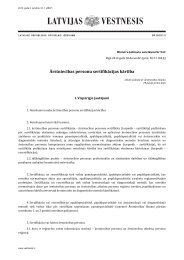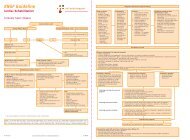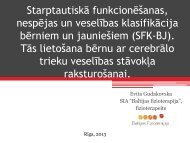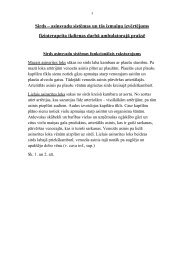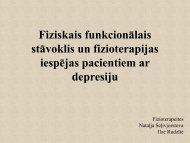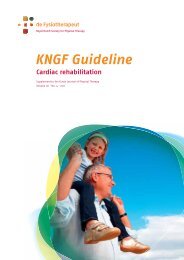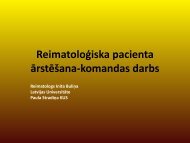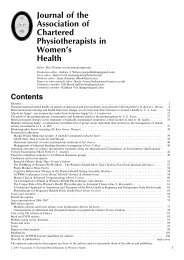You also want an ePaper? Increase the reach of your titles
YUMPU automatically turns print PDFs into web optimized ePapers that Google loves.
<strong>Low</strong> <strong>Back</strong> <strong>Pain</strong>: Clinical Practice Guidelines<br />
tively). The McKenzie group showed improvement in level<br />
of disability compared to the manipulation group, reaching a<br />
statistical significance at 2 and 12 months’ follow-up.<br />
Clinicians should consider utilizing repeated move-<br />
A ments, exercises, or procedures to promote centralization<br />
to reduce symptoms in patients with acute<br />
low back pain with related (referred) lower extremity pain.<br />
Clinicians should consider using repeated exercises in a specific<br />
direction determined by treatment response to improve<br />
mobility and reduce symptoms in patients with acute, subacute,<br />
or chronic low back pain with mobility deficits.<br />
FLEXION EXERCISES<br />
Flexion-based exercises, also called Williams flexion exercises,<br />
have long been considered a standard treatment for<br />
patients with lumbar spinal stenosis. It has been reported<br />
that flexion-specific exercise classification appears to be less<br />
common and most often occurs in patients who are older,<br />
often with a medical diagnosis of lumbar spinal stenosis. 107<br />
Current guidelines detailing conservative intervention for<br />
stenosis recommend repeated flexion exercises in the supine,<br />
seated, and standing positions. 30 A recent review article<br />
by <strong>Back</strong>strom et al 14 note that flexion-based exercises<br />
have long been utilized to theoretically open or expand the<br />
cross-sectional area of the foraminal canals and central spinal<br />
canal, thus potentially relieving mechanical compression<br />
of the lumbar nerve roots, improving spinal flexibility, and<br />
improving hemodynamics.<br />
A multicenter randomized controlled trial by Whitman<br />
et al316 II<br />
compared 2 physical therapy programs<br />
for patients with both imaging studies and clinical<br />
presentation consistent with central lumbar spinal stenosis.<br />
The authors randomized 58 patients with lumbar spinal stenosis<br />
to 1 of 2 six-week physical therapy programs: (1) a manual<br />
therapy, exercise, and body weight–supported treadmill<br />
walking group; and (2) a lumbar flexion exercise, treadmill<br />
walking, and walking program group. Patients in the manual<br />
therapy group reported greater recovery at 6 weeks, with a<br />
number needed to treat of 2.6. At 1 year, 62% of the manual<br />
therapy group continued to have successful outcomes as compared<br />
to 41% in the flexion-based exercise group.<br />
A cohort study by Murphy et al223 utilized flexion-<br />
III based exercises as a component of a treatment<br />
program also utilizing long-axis distraction manipulation<br />
and nerve mobilization procedures in a population<br />
of patients with both clinical findings and imaging findings<br />
of central, lateral, or combined central and lateral lumbar<br />
spinal stenosis. Patients were instructed in a quadruped exercise<br />
emphasizing lumbar flexion and extension to improve<br />
a36 | april 2012 | volume 42 | number 4 | journal of orthopaedic & sports physical therapy<br />
overall joint mobility. The mean improvement in disability as<br />
measured by the Roland-Morris Disability Index score was<br />
5.1 points from baseline to discharge, and 5.2 points from<br />
baseline to long-term follow-up, satisfying the criterion for<br />
minimum clinically important difference. <strong>Pain</strong> at worst was<br />
also reduced by a mean of 3.1 points using the 0-10 numeric<br />
pain rating scale.<br />
Simotas et al273 performed a prospective cohort<br />
III study following 49 patients with radiographic central<br />
canal lumbar spinal stenosis for a mean of 33<br />
months, with treatment consisting of daily flexion-based exercises.<br />
At 3-year follow-up, 9 patients had undergone surgical<br />
intervention. Of the 40 patients who did not undergo<br />
surgery, 5 reported worsening of symptoms, 12 reported no<br />
change, 11 reported mild improvement, and 12 reported sustained<br />
improvement. Twelve of these 40 patients who did not<br />
undergo surgery reported having no pain or only mild pain.<br />
Clinicians can consider flexion exercises, combined<br />
C with other interventions such as manual therapy,<br />
strengthening exercises, nerve mobilization procedures,<br />
and progressive walking, for reducing pain and<br />
disability in older patients with chronic low back pain with<br />
radiating pain.<br />
LOWER-QUARTER NERVE MOBILIZATION<br />
PROCEDURES<br />
George121 published a case series of 6 patients with<br />
IV subacute low back pain and leg symptoms who (1)<br />
were unable to improve or worsen their symptoms<br />
with lumbar flexion and extension motions, and (2) had a<br />
positive slump test. All patients were treated with end-range<br />
nerve mobilization (passive slump and straight leg raise<br />
stretching) procedures. All patients demonstrated reductions<br />
in numeric pain rating. Five of 6 patients reported a<br />
reduction or elimination of their thigh, lower-leg, or foot<br />
symptoms, in which 2 patients no longer had symptoms and<br />
3 patients reported the location of symptoms to be in a more<br />
proximal location at discharge. These 5 patients had an average<br />
of 8 treatment sessions each.<br />
Cleland et al65 completed a randomized controlled<br />
trial (n = 30) using the same eligibility criteria as<br />
the George121 II<br />
case series. Patients with low back<br />
complaints, with symptoms distal to the buttocks, who had<br />
reproduction of symptoms with the slump test and had no<br />
change in symptoms with lumbar flexion or extension were<br />
randomized to receive nonthrust mobilization of the lumbar<br />
spine and exercise or slump stretching and exercise. Patients<br />
were treated for 6 sessions. At discharge, the slump-stretching<br />
group exhibited significantly reduced disability; overall



